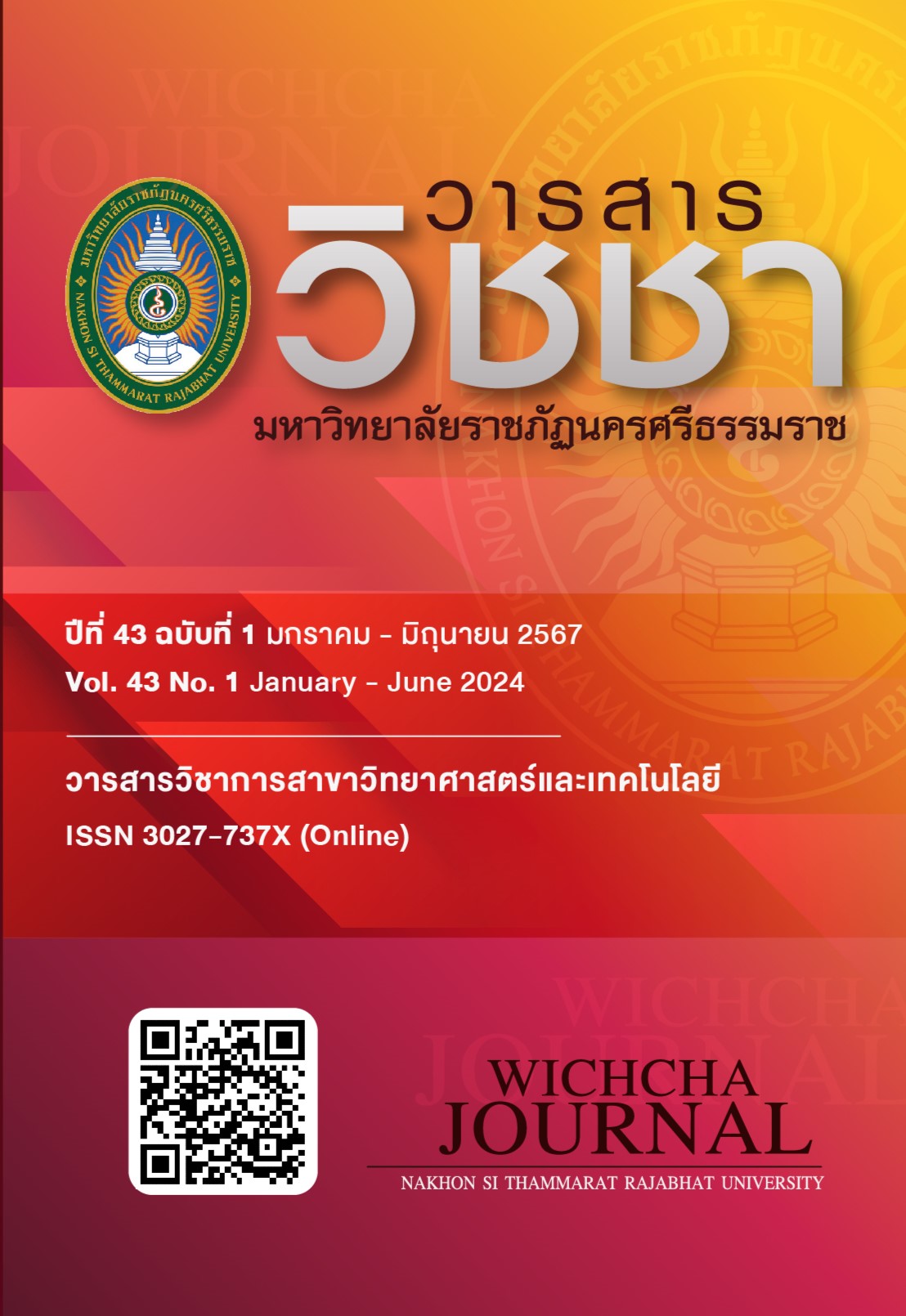The Development of Preserved Tamarind Packaging for Export Processed Fruit Producer Community Enterprise in Ban Khlong Chon, Sa Kaeo Province
Main Article Content
Abstract
Preserved tamarind from Exporting Processed Fruit Producer Community Enterprise in Ban Khlong Chon, Sa Kaeo province were packed in aluminum foil zip lock pouch with clear front window. The problem was zip lock bags were bloated and torn during transportation. Therefore, this research aimed to study effects of a new package on the quality of preserved tamarind during storage. In this study, preserved tamarind were packed in polyethylene terephthalate (PET) cans with valve silver peel of end aluminum lid, sealed by a can sealing machine and stored at temperature room (30±2 °C) for 10 days and refrigerator temperature (4±2 °C) for 28 days. New product label was also designed. Results showed that preserved tamarind could be stored at room temperature only for 4 days and at refrigerator temperature longer than 28 days. Temperature had an effect on the quality of preserved tamarind as they became pale yellow, lightness (L*) increased, yellowness (b*) decreased and alkalinity increased. Total soluble solid decreased with statistical significance (p ≥ 0.05). Sensory evaluation revealed that consumers gave decreased preference scores to preserved tamarind stored at room temperature and refrigerator temperature from very much liked to moderately liked and neither liked nor disliked, respectively, Throughout the storage period, total bacteria count was less than 1x106 colony-forming units per gram (CFU/g) and total yeast and mold count was less than 1x103 CFU/g, which did not exceed the standard required by Thai Industrial Standards Institute (TISI). With regard to the product label design, consumers gave satisfaction scores towards the new product label as it is attractive, clear, and communicate the outstanding point of preserved tamarind at a high level, accounting for 83.60%. The new package can be used actually to solve the damage problems during transportation and can be used as a guideline for other kinds of preserved fruits.
Article Details

This work is licensed under a Creative Commons Attribution-NonCommercial-NoDerivatives 4.0 International License.
เนื้อหาและข้อมูลในบทความที่ลงตีพิมพ์ในวารสารวิชชา มหาวิทยาลัยราชภัฏนครศรีธรรมราช ถือเป็นข้อคิดเห็นและความรับผิดชอบของผู้เขียนบทความโดยตรง ซึ่งกองบรรณาธิการวารสารไม่จำเป็นต้องเห็นด้วยหรือร่วมรับผิดชอบใด ๆ
บทความ ข้อมูล เนื้อหา รูปภาพ ฯลฯ ที่ได้รับการตีพิมพ์ในวารสารวิชชา มหาวิทยาลัยราชภัฏนครศรีธรรมราช ถือเป็นลิขสิทธ์ของวารสารวิชชา มหาวิทยาลัยราชภัฏนครศรีธรรมราช หากบุคคลหรือหน่วยงานใดต้องการนำข้อมูลทั้งหมดหรือส่วนหนึ่งส่วนใดไปเผยแพร่ต่อหรือเพื่อการกระทำการใด ๆ จะต้องได้รับอนุญาตเป็นลายลักษณ์อักษรจากวารสารวิชชา มหาวิทยาลัยราชภัฏนครศรีธรรมราชก่อนเท่านั้น
The content and information in the article published in Wichcha journal Nakhon Si Thammarat Rajabhat University, It is the opinion and responsibility of the author of the article. The editorial journals do not need to agree. Or share any responsibility.
References
ฐิติมา มาใหญ่ และผกาวดี เอี่ยมกำแพง. (2557). การประเมินคุณค่าทางโภชนาการและอายุการเก็บรักษาของผลิตภัณฑ์มะม่วงแช่อิ่ม. ใน การประชุมวิชาการระดับชาติราชภัฏเพชรบุรีวิจัยเพื่อแผ่นดินไทยที่ยั่งยืน ครั้งที่ 4 (หน้า 241-246). เพชรบุรี: มหาวิทยาลัยราชภัฏเพชรบุรี.
ธีรพร กงบังเกิด. (2546). จุลชีววิทยาทางอาหาร. พิษณุโลก: ภาควิชาอุตสาหกรรมเกษตร คณะเกษตรศาสตร์ ทรัพยากรธรรมชาติและสิ่งแวดล้อม มหาวิทยาลัยนเรศวร.
บุษกร อุตรภิชาติ. (2550). จุลชีววิทยาทางอาหาร. (พิมพ์ครั้งที่ 3). สงขลา: ภาควิชาชีววิทยา คณะวิทยาศาสตร์ มหาวิทยาลัยทักษิณ.
ปรภัทร คงศรี. (2564). การพัฒนาฉลากผลิตภัณฑ์ท้องถิ่นให้ดึงดูดความสนใจนักท่องเที่ยวชาวต่างชาติในอำเภอเมือง จังหวัดแม่ฮ่องสอน. วารสารมนุษยศาสตร์และสังคมศาสตร์ มหาวิทยาลัยมหาสารคาม, 40(6), 79-92.
ปิยะวรรณ กาสลัก และรัชฎาพร อุ่นศิวิไลย์. (2558). โปรไบโอติกและเชอร์รี่เปรี้ยวหมักเสริมสุขภาพ. รายงานวิจัย. มหาวิทยาลัยเทคโนโลยีสุรนารี. นครราชสีมา.
พรพิมล ขำเพชร ปาริฉัตร ศรีหะรัญ และวันดี หิรัญสถาพร. (2564). ความสำคัญและเทคนิคการรวบรวมข้อมูลสู่การวิจัยในศตวรรษ 21. วารสารศึกษาศาสตร์ มหาวิทยาลัยบูรพา, 32(2), 1-12.
สถาบันอาหาร. (2547). หลักการผลิตและฆ่าเชื้ออาหารในภาชนะปิดสนิทด้วยความร้อน. กรุงเทพฯ: สถาบันอาหาร.
สำนักงานมาตรฐานผลิตภัณฑ์ชุมชน. (2546). มาตรฐานผลิตภัณฑ์ชุมชนผลไม้ดอง, มผช.160/2546, กรุงเทพฯ.
สำนักงานมาตรฐานผลิตภัณฑ์ชุมชน. (2558). มาตรฐานผลิตภัณฑ์ชุมชนผักและผลไม้แช่อิ่ม, มผช. 161/2558, กรุงเทพฯ.
AOAC. (2000). Official methods of analysis. (17th ed). Virginia: Association of Official Analytical Chemists.
Bacteriological Analytical Manual Online (BAM). (2001). Chapter 3: Aerobic plate count. Retrieved 20 May 2022, from: https://www.fda.gov/food/laboratory-methods-food/bacteriological-analytical-manual-bam.
Best, J.W. (1981). Research in education. (3rd ed). New Jersey: Prentice Hall, Inc.
Bozkir, H. and Ergün, A.R. (2020). Effect of sonication and osmotic dehydration applications on the hot air drying kinetics and quality of persimmon. LWT-Food Science and Technology, 131, doi: https://doi.org/10.1016/j.lwt.2020.109704.
De Aguiar Cipriano, P., Ekici, L., Barnes, R.C., Gomes, C., Talcott, S.T. (2015). Pre-heating and polyphenol oxidase inhibition impact on extraction of purple sweet potato anthocyanins. Food Chemistry, 180, 227-234, doi: https://doi.org/10.1016/j.foodchem.2015.02.020.


